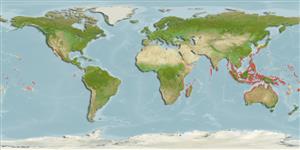Environment: milieu / climate zone / depth range / distribution range
นิเวศวิทยา
เกี่ยวกับทะเล,น้ำเค็ม; น้ำจืด; กร่อย เกี่ยวกับหินโสโครก; สัตว์น้ำที่อพยพไปๆมาๆ ระหว่างแหล่งน้ำจืดกับทะเล ที่เป็นไปตามช่วงชีวิต (Ref. 46888); ระดับความลึก 0 - 1 m (Ref. 86942). Tropical
Indo-Pacific: along East African coast, from Zululand in South Africa northwards to the Red Sea and most of West Indian Ocean islands (Ref. 4756); further east to the Marianas and Samoa; north to Ryukyu Islands, south to western Australia and Oceania (Ref. 2334).
Length at first maturity / ขนาด / น้ำหนัก / Age
Maturity: Lm 5.0 range ? - ? cm
Max length : 19.0 cm TL เพศผู้/กระเทย; (Ref. 4756)
เงี่ยงครีบหลัง (รวม): 12 - 18; ก้านครีบอ่อนที่หาง (รวม): 9-12; เงี่ยงครีบก้น 1; ก้านครีบอ่อนที่ก้น: 8 - 11. Diagnosis: Distinguished by the following characteristics: pelvic fins lacking frenum; little or no membrane uniting medial most pelvic rays; first dorsal fin height moderate, its margin usually convex, occasionally straight, with a black stripe inframarginally and numerous small, white spots posteriorly on fin, no elongate spines; second dorsal fin with single, dusky stripe mesially; dorsal fins not connected by membrane; first dorsal fin with 11-16 spines; longitudinal scale count 64-100; head width 14.3-22.6% of standard length; pelvic fin length 11.3-15.2% of standard length; length of anal fin base 14.0-19.4% of standard length; length of second dorsal-fin base 17.6-23.7% of standard length; total D2 elements 10-13; total anal fin elements 9-12; TRDB 18-26 (Ref. 5218).
Facultative air-breathing (Ref. 126274); A resident intertidal species with homing behavior (Ref. 32612, 48637) and amphibious air-breather (Ref. 31184, 79840), found in brackish mud flats in mangrove and nipa palm areas. Found in both littoral and estuarine; able to climb out of water, in mangrove swamps and burrowing into intertidal mud banks (Ref. 4756). Occasionally in the lower parts of freshwater streams (Ref. 2847, 44894, 48637, 79840). Actively shuttling back and forth between rock pools and air (Ref. 31184). It feeds on worms, crustaceans, and insects (Ref. 37816). Can stay out of the water for up to 37 h if kept moist (Ref. 51276).
Life cycle and mating behavior
วัยเจริญพันธุ์ | การสืบพันธุ์ | การวางไข่ | เซลสืบพันธ์ของเพศเมีย(ไข่) | ความดกของไข่ | ตัวอ่อน
Murdy, E.O., 1989. A taxonomic revision and cladistic analysis of the oxudercine gobies (Gobiidae: Oxudercinae). Rec. Aust. Mus., Suppl. 11:1-93. (Ref. 5218)
IUCN Red List Status (Ref. 130435)
Threat to humans
Harmless
Human uses
การประมง: ไม่มีผลประโยชน์; สถานที่แสดงสัตว์และพืชน้ำ: การค้า
ข้อมูลเพิ่มเติม
ชื่อสามัญชื่อพ้องกลไกการเผาผลาญพลังงานผู้ล่าการศึกษาเกี่ยวกับผลกระทบของสารประกอบทางเคมีที่เป็นอันตรายต่อสิ่งมีชีวิต ประชากร และสิ่งแวดล้อมการสืบพันธุ์วัยเจริญพันธุ์การวางไข่การรวมกลุ่มวางไข่ความดกของไข่เซลสืบพันธ์ของเพศเมีย(ไข่)Egg development
อ้างอิงการเพาะเลี้ยงสัตว์น้ำประวัติการเพาะเลี้ยงสัตว์น้ำสายพันธุ์พันธุศาสตร์ElectrophoresesอัตราพันธุกรรมโรคการแปรรูปNutrientsMass conversion
เครื่องมือ
Special reports
Download XML
แหล่งที่มาจากอินเตอร์เน็ต
Estimates based on models
Preferred temperature (Ref.
123201): 24.2 - 29.3, mean 28.4 °C (based on 2897 cells).
Phylogenetic diversity index (Ref.
82804): PD
50 = 0.5000 [Uniqueness, from 0.5 = low to 2.0 = high].
Bayesian length-weight: a=0.01072 (0.00495 - 0.02318), b=2.97 (2.79 - 3.15), in cm total length, based on LWR estimates for this Genus-body shape (Ref.
93245).
ระดับชั้นอาหาร (Ref.
69278): 3.3 ±0.40 se; based on food items.
ความสามารถในการกลับคืนสู่ปกติ (Ref.
120179): ความสูง, เวลาต่ำสุดที่จะทำให้ประชากรเพิ่มขึ้นเป็น 2 เท่าใช้เวลาน้อยกว่า 15 เดือน (Preliminary K or Fecundity.).
Fishing Vulnerability (Ref.
59153): Low vulnerability (10 of 100).
Nutrients (Ref.
124155): Calcium = 90.6 [43.9, 190.3] mg/100g; Iron = 0.678 [0.320, 1.287] mg/100g; Protein = 19 [17, 21] %; Omega3 = 0.104 [0.045, 0.218] g/100g; Selenium = 11.5 [5.6, 24.8] μg/100g; VitaminA = 115 [29, 427] μg/100g; Zinc = 2 [1, 3] mg/100g (wet weight);
